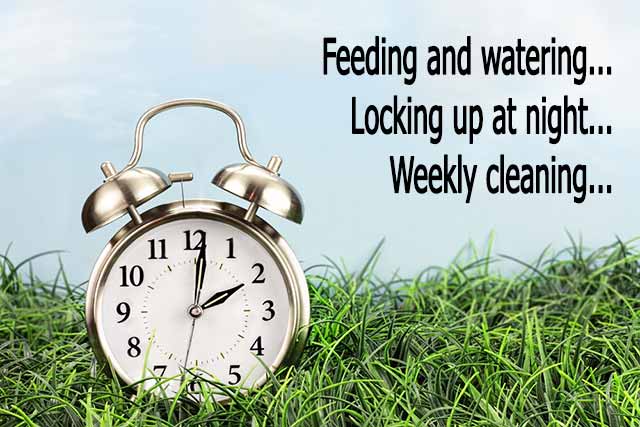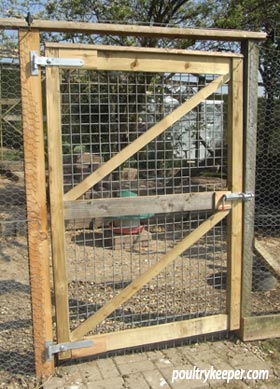Keeping a few chickens in the back yard really is quite straight forward; however there are some things to consider in order to get the right sort of birds for your situation and to keep them in the best possible health to get the most enjoyment out of keeping them.
This page hopes to get you thinking about the types of chickens and their requirements.
Choosing a breed
There are quite literally hundreds of different breeds of chicken to choose from and out of these, many have slightly different requirements.
Some breeds of chicken come only as Large Fowl, and others are also available as Bantams which are a smaller version that look the same. The Orpington for example is available in both large and bantam sizes but the Cochin is only available as large fowl.
There are a handful of ‘True Bantams’ where there is no large fowl equivalent. Examples of these are Dutch Bantams, Japanese Bantams and the popular Pekin Bantam.
Bantams tend to be quite flighty whereas the heavy breeds of large fowl often cannot fly more than a few inches off the ground. Orpingtons for example won’t usually roost very high due to their huge size and will usually just huddle on the floor of the coop.
Every breed is slightly different in the amount of eggs they lay. Typically hens that have been bred for exhibition purposes do not lay as well as utility hens. Bantams of course lay smaller eggs which some people say they prefer for taste.
Hybrids
 Hybrids are chickens that have been created by crossing pure breeds. They are typically crossed to make good layers (the hybrid to the right can lay 280 to 300 eggs!), coloured eggs or attractive hens. Some can be very attractive and they are all generally very hardy. Hybrids are produced in larger numbers that pure breeds and most of the crosses used make the males a different colour as day old chicks so that only females can be raised, therefore reducing costs by about half. A typical hybrid hen will cost you around £15 compare to £25 to £30 for a typical pure breed hen.
Hybrids are chickens that have been created by crossing pure breeds. They are typically crossed to make good layers (the hybrid to the right can lay 280 to 300 eggs!), coloured eggs or attractive hens. Some can be very attractive and they are all generally very hardy. Hybrids are produced in larger numbers that pure breeds and most of the crosses used make the males a different colour as day old chicks so that only females can be raised, therefore reducing costs by about half. A typical hybrid hen will cost you around £15 compare to £25 to £30 for a typical pure breed hen.
Hybrids are a good choice if eggs are one of your priorities although if you think you might like to hatch some eggs, remember hybrid hens do not breed true – you would need the original pure breeds to cross again in order to create more of the same thing so whilst you can hatch their eggs, you may want to consider a few pure breeds for this purpose or consider buying in eggs to hatch.
Free Range
You will of course need a chicken coop but also a secure run or area that is predator proof. A question that people always ask me is “How big should their run be?” I always say “as big as possible within reason.” Even 2 chickens kept in a 2 meter run will soon turn it to mud and get bored (which can introduce vices such as feather pecking and egg eating) but I always believe that it’s fine to provide a small run like this if you can let them out for a few hours each day to free range while you are around. This will give them a chance to forage, supplement their diet and reduce boredom.
Once chickens have settled into their new house, they will go back to it to roost every night so you can let them out in the late afternoon, knowing they will come back to roost at night keeping everyone happy! Some houses and runs have handles or wheels that make them easy to move onto fresh ground which is not only good to prevent a build up of worm eggs and disease but also provides them with a little fresh grass to graze.
Keeping Chickens in the Garden
If you have a ‘nice’ garden that you don’t want spoilt, it’s usually a sensible idea to limit their foraging. Chickens scratch at the ground, make dust baths in the dry soil, leave muck wherever they go and destroy tender young plants. If you can plant in pots, this will help and fencing off part of the garden is usually a good choice to keep them out if you have tender or precious plants. Chickens with feathered feet scratch less and bantams can clear a 6 foot fence if they want to. Heavy breeds of large fowl can be kept out with a knee high fence or box hedge. If you want to stop a bird from flying then you can clip one wing (not both).
So you have decided on the breed that’s right for you and your circumstances. Next, you will need to think about keeping them secure from predators in a suitable chicken house and chicken run – click on a link to go to that page!








hi, great website, but just a couple of questions. my coop will be on concrete so would you recommend straw or hay ? different people say different things and i’m putting a dust bath in the coop so what would you recommend i use in that ?
thanks
Neither… both get compacted easily and need changing regularly. I would use 4 or 5 inches of wood chippings. They can scratch through it and you can change it from time to time.
Hi I love my chickens but what do people do with them when they stop laying.
Many keep them, adding a few young layers to keep the egg supply going although some might dispatch them.
hi, we have just bought a chicken shed 6ft by 4ft and are going to build a run off it. we are unsure about what surface they will need inside and out as we have never had chickens before but would like some for eggs. Also, how many chickens would you reccommend we have in this sort of space? thank you, Kate
Inside, you want to be able to scrape it clean. Ideally a concrete base to stop rats going underneath and then a wooden floor made of ply or similar. A droppings board raised up, under perches helps to make cleaning easy.
Have a read of my page about Chicken runs for ideas of surfaces you can use.
I would really like to start keeping hens, however i live in a town house which has a concrete back yard, is this type of groundcover unsuitable for happy hens? The ‘yard’ has high walls (approx 5ft), and has a ground area of around 65ft… PS. Love your site, it is the most helpful i have found to date. Thank you
Yes sounds ok but I would provide a good run with wood chippings for scratching and they would need greens daily.
This is such a helpful site. What influences the depth of colour and the flavour of the egg yolk? Is it the breed or the feed? Or both? I’ve bought richly coloured and flavoured eggs and some which were pale yellow and bland, all free range. How would I ensure that my hens’ eggs were like the former?
Yolk color in eggs is linked to the diet of the hens. Yolks will be a darker yellow if a hen’s feed includes maize (the yellow bits found in mixed corn) and alfalfa meal. Pigments are often added to layers feeds, usually derived from marigold petals or red peppers. Fresh green grass also provides rich yolk colour and is often why people say that free range eggs have a better yolk colour.
Yolks can be pale in winter as the grass isn’t growing.